Part-Leaf from a Large-Format Lectionary
April 12, 2016 in Manuscript Studies, Photographic Exhibition
Parts of I Maccabees 10 and
Homily 38 on the Gospels by Gregory the Great
Fragmentary leaf probably from a large-format Lectionary
Parts of I Maccabees 10 and
Homily XXXVIII on the Gospels by Gregory the Great
Reduced to the lower part of the former leaf
for reuse as a wrapper or binder for unknown materials
Budny Handlist 2
Here is the next in our series of blogposts on Manuscript Studies, which have an updated Contents List. This time, Mildred Budny reports on another item in her Handlist of a set of materials in manuscript and print. Earlier posts considered its Numbers 4, 7, 9, 11, and 13. This time, we visit a 12th-century fragment found in Italy and published here for the first time.
Data
Circa 334 × 243 mm < written area now circa 234 × 222 mm >
Double columns now of 25 lines (trimmed down at the top and side)
written in revived Caroline Minuscule in brown ink
Opening title or heading in 1 or 3 lines in red pigment
Inset 6-line initials in red pigment (I for In and T for Textum),
with embellishments in blue or green
for geometric and foliate ornament
Probably Italy, perhaps Northern Italy, circa 1175
Sources
The fragment of a vellum leaf with double columns of text in Latin was acquired in Italy in its present fragmentary state, without any indications of its provenance, its original manuscript setting, or its former enclosed materials which it covered as a folder or wrapper in its secondary folded state. The fold-lines un-related to the original structure of the leaf attest mutely, but still manifestly, to that former state.
Identifying the texts on the leaf makes it possible to ascertain, in its reduced state, which side was the recto and which was the verso originally. They show that the layout turned the smooth, whitish flesh-side of the animal skin to the recto, with the yellower hair-side on the verso. The peppered traces of hair follicles mark the latter.
Up Front & Back
Recto
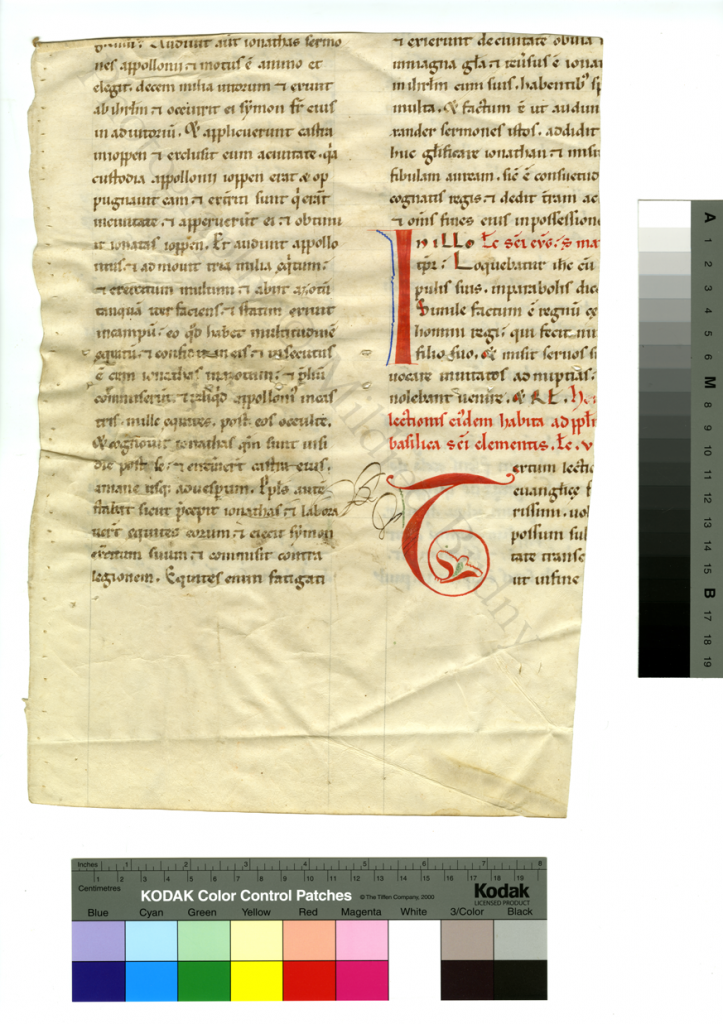
Verso
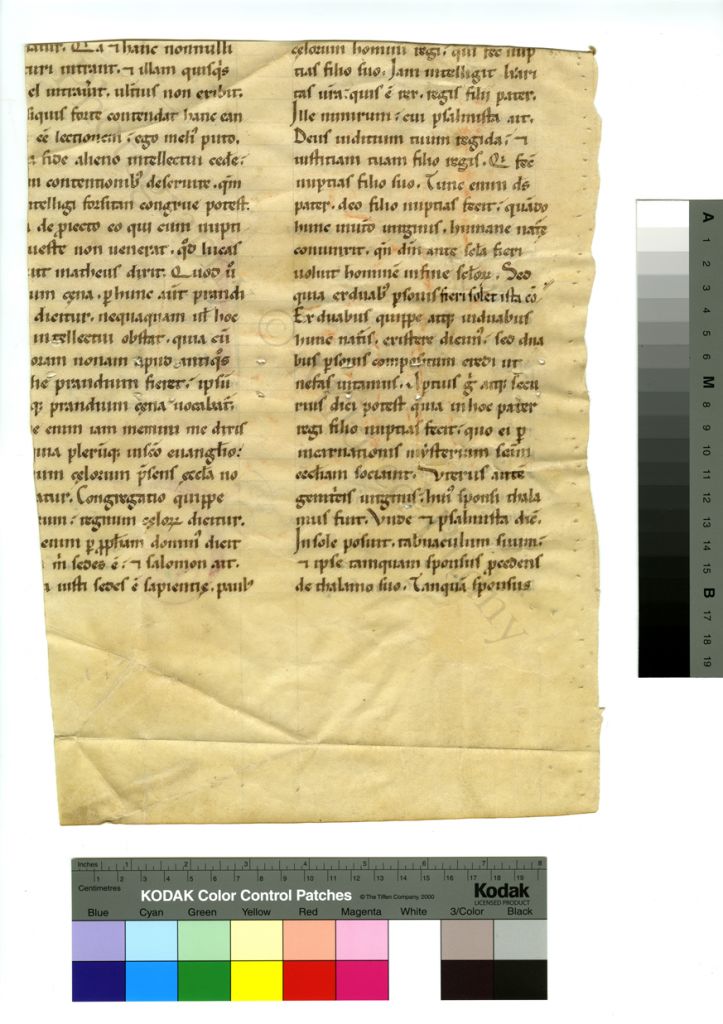 Shapes & Guides
Shapes & Guides
Trimming the leaf unevenly for its reuse as a wrapper involved imposing roughly horizontal or vertical strokes at its new top and outer edges and a jagged contour along its inner margin, while appearing to leave the original lower margin more-or-less intact. The inner contour skirts an uneven line of more-or-less horizontal slits or pricks which runs down the full height of the surviving fragment. These marks, presumably the result of jabs of varying force with the point of a knife, do not represent any prickings which would have set out the grid to guide the rulings for the lines of original script. Their rôle remains uncertain.
Two roughly horizontal and paired rows of gouge-like holes extend across the mid-section of the fragment. Presumably they were designed for stitching of some sort at both edges of the new spine or backing of the reused unit.
Some original prickings are visible in the neatly rounded holes, resulting from the point of an awl. They guided the long vertical rulings for the columns; they extend far into the lower margin. Their neatness contrasts emphatically with the rows of rough gouges and slits.
Transmission
The fragment was acquired as a separate leaf by purchase from the Libreria Leo S. Olschki in Florence, Italy, for US $10 on 20 June 1972, along with 4 other items with their own prices — including Budny Handlist Numbers 7, 18, and 20; the last item is not yet identified.
The Texts
The leaf not only carries portions of texts which begin or end abruptly, but also gathers texts, or extracts, from longer series or sets of texts. They circulated in their original contexts as part of Bibles (in small, medium, or large formats) or homiliaries (also in various formats). Here the headings which note lections designate selected readings, for comparison and contrast, in which an Old Testament reading preceded a patristic reading, in part or in full.
1. I Maccabees 10:73 ([fu-]/giendi) to 89 (possession[em])
The first text extends from within the last word of verse 73 in I Maccabees 10 in the Latin Vulgate Version to the end of the chapter, that is, with verse 89, but the losses at the top and outer side of the leaf introduce gaps. They concern whole lines of text missing from within verse 82 (erant) to within 86 (Ascolona) at the lost top of column b, as well as a few letters — 2 or more — at the lost ends of the lines in the rest of column b. This whole portion of the chapter concerns the victory at Azotus/Ashdod (in 147 BCE) of Jonathan Apphus over Apollonius Taos, Governor of Coele-Syria, with the acquisition of booty and the loss of 8,000 men.
Text and Lacunae
For convenience, I offer a transcription of the surviving text, drawn from an online edition of the Latin Vulgate Bible, but laid out according to the manuscript line-divisions. I add hyphens to the word-divisions from one manuscript line to the next. The customary verse numbers of the edition — a finding aid which the Bible text acquired at a somewhat later stage in its transmission than this 12th-century witness — are retained as a guide. The lost parts of the text are indicated in red.
[The preceding page would have ended thus, more-or-less, if it followed the standard text:
73 et nunc quomodo poteris sustinere equitatum exercitum tantum in campo ubi non est lapis neque saxum neque locus fu-/]
[Recto Column a begins midword:]
giendi 74 ut audivit autem Ionathas sermo-
nes Apollonii motus est animo et
elegit decem milia virorum et exiit
ab Hierusalem et concurrit ei Simon frater eius in
adiutorium 75 et adplicuerunt castra
in Ioppen et exclusit eum a civitate quia
custodia Apollonii Ioppe erat et ob-
pugnavit eam 76 et exterriti qui erant
intra civitatem aperuerunt ei et obtinu-
it Ionathas Ioppen 77 et audivit Apollo-
nius et admovit tria milia equitum
et exercitum multum 78 et abiit Azotum
tamquam iter faciens et statim exiit
in campum eo quod haberet multitudinem
equitum et confideret in eis et insecutus
est eum Ionathas in Azotum et proelium
commiserunt 79 et reliquit Apollonius in cas-
tris mille equites post eos occulte
80 et cognovit Ionathas quoniam sunt insi-
diae post se et circuierunt castra eius
a mane usque ad vesperam 81 populus autem
stabat sicut praecepit Ionathas et labora-
verunt equi eorum 82 et eiecit Simon
exercitum suum et commisit contra
legionem equites enim fatigati
[Recto Column a ends /]
[The top of Recto Column b would have begun here:]
[erant et contriti sunt ab eo et fugerunt
83 et qui dispersi sunt in campum fugerunt in Azotum et intraverunt in Bethdagon idolum suum ut se liberarent
84 et succendit Ionathas Azotum et civitates quae erant in circuitu eius et accepit spolia eorum et templum Dagon et eos qui fugerunt in illud succendit igni
85 et fuerunt qui ceciderunt gladio cum his qui succensi sunt fere octo milia virorum
86 et movit inde Ionathas castra et adplicuit ea Ascalona
[The remaining part of this text in Recto Column b begins:]
et exierunt de civitate obviam illi
in magna gloria 87 et reversus est Ionathas
in Hierusalem cum suis habentibus spolia
multa 88 et factum est ut audivit Ale-
xander rex sermones istos addidit ad-
huc glorificare Ionathan 89 et misit ei
fibulam auream sicuti est consuetudo dari
cognatis regum et dedit ei Accaron
et omnes fines eius in possessionem
The text is set out in long lines, with run-together sections (or verses), in space-saving fashion. For ease of legibility, the sections open with enlarged initials, written in the course of writing the text itself. Entered by the scribe at the same time, the punctuation, which indicates a hierarchy of pauses, from medial to final, corresponds to contemporaneous practices for the purpose of reading aloud in monastic settings. It marks the layout of the consecutive sense-units for enhanced, and immediate, ease of comprehension of the structure of the passage. Those marks comprise low or medial points and the punctus versus (resembling an inverted semi-colon).
2. Homily 38 on the Gospels by Gregory the Great:
Habita ad populum in basilica beati Clementis martyris
In the series of the Homilies on the Gospels by Gregory the Great, this is his Sermon
‘Delivered to the People at the Basilica of the Blessed Martyr Clemente’
This homily had its debut at the Basilica of San Clemente in Rome. Much changed over the centuries, the interior of this early basilica of the Christian Church nowadays has this august and polychrome appearance, shown here in a public image. Visiting the place, including its subterranean structures, as I can attest, evokes an awareness of the majesty and tangibility of the place.
I continue to remember, in my acute mind’s eye, the experience of walking through its different spaces, above and below ground level, illuminated through time. Such visits occurred during my several visits to Rome, mainly for the purpose of studying manuscripts at the Biblioteca Apostolica Vaticana, but also, during its closing hours, for the purpose of wandering around the majestic city and exploring its many vistas. Already I had learned, through listening to lectures or reading articles and books, about this church and its medieval history and transformations.
On one of my visits, there was the good fortune of visiting the basilica in the company of Father Leonard Boyle (1923–1999), after he had retired as Prefect of the Vatican Library, and returned to domicile in that establishment. My visits to him and his Library during his Prefecture are also worth recording, but they belong to another story of research and consultation.
Despite the many changes wrought upon the church, as a living and venerable entity, it may be worthwhile for us to experience the sense of location, however we might, up close or from afar, or in a combination of those processes. Sights, sounds, smells, touch. That’s how we taste the materials in their settings, anyway in our vivid, vigorous, and informed imagination.
Once upon a Time, Long Ago, Homily 38 by Gregory the Great had its first hearing in the space of this place. Across time, its reverberation in many other other spaces depended mainly upon the transmission of the text in manuscript and, then, in print. As a popular text, its copies are many and the variants in their readings are plentiful. A vibrant text.
Some manuscripts contain, or retain, either Book I or II. Some, as here, intersperse its readings with other texts. Also, they exhibit, as here, some liberty with the text of Matthew, that is, by varying the Gregorian version with one more familiar, for whatever reason.
Arrangement and Presentation
Similar layout and punctuation as for the Maccabees portion pertains to the next text on ‘our’ leaf. However, there are the further elements of rubricated titles in 1 or 3 lines, prominent bi-chrome initials for both its opening title and the opening of the homily (I for In and T for Textum), and strokes of red pigment enlivening some of their next letters. The geometric and floral ornament which embellish the initials allow for some grace within a work-a-day copy destined for day-to-day use in the course of the liturgical and communal year. Examples of such destinations, in various ways and for various purposes, are revealed in reports of A New Leaf from ‘Otto Ege Manuscript 14’ and A Part-Leaf from the ‘Life of Saint Blaise’.
Author and Reception
Gregory the Great (circa 540 – 604), Pope from 590–604, composed his series of 40 Homilies on the Gospels, designed for the liturgical year, by 593. The ensemble is divided symmetrically into 2 Books, with 20 Homilies each. The Homilies as a whole were delivered during the years 591 and 592, variously by their author and by a proxy during his illness. Those conditions of delivery are recorded. A popular text, or set of texts, in the Middle Ages, the series circulated as a whole or — as here — individually, or, it may be, in parts, in the context of some other text(s). Some manuscripts contain, or retain, Books I or II. Some intersperse readings from one or another Homily with other texts, as here.
A future Blogpost will consider an earlier fragment from Carolingian realms (with portions from Book I). They call for detailed consideration about the nature and transmission of Gregory’s text, in more than one recension.
Meanwhile, as reference points, I offer citations of editions and of translations into French or English, more-or-less readily available:
- Jacques-Paul Migne, Patrologia cursus completus . . . Series latina, volume 78 (Paris, 1879)
https://books.google.com/books?id=YY3YAAAAMAAJ
- Gregorius Magnus, Homiliae in Evangelia, edited by Raymond Étaix. Corpus Christianorum Series Latina, 141. (Turnhout, 1999)
- Grégoire le Grand, Homélies sur l’Évangile, translated into French, with introduction and notes, by Raymond Étaix, Charles Morel, and Bruno Judic. Sources Chrétiennes, 485 (Paris, 2005)
- Gregory The Great, Forty Gospel Homilies, translated by David Hurst. Cistercian Studies Series 123 (1990)
According to Étaix’s proposed list of the intended occasions and the dates of first delivery of the individual Homilies (page lxx), for which some precise dates, including years, are known, Homily XXXVIII is for ‘Dim[anche].’, with initial delivery on ’27 janv[ier] ou 3 février’. A future post about a Carolingian fragment from these Homilies (with portions from Book I) will tell more about the nature of the text and its transmission.
Transcription of the Text, Variant Readings, and a Scribal Mistake
Here my transcription, expanding abbreviations mostly silently (apart from the titles, where abbreviations are expanded in italics), draws upon the online edition of the Patrologia Latina (columns 1281–1284), as well as that in print by Étaix (pages 359–362). Likewise my version adds their section numbers and both signals quotations from Scripture by italics and cites the location of their passages in square brackets. But unlike those editions, it conforms with the manuscript line-divisions and adds hyphens to words divided from one line to the next. It also notes the variant readings of the manuscript. Editorial notes stand within square brackets. There can be found the variants from the standard edition(s).
Because it is uncertain how many lines of text stood above the survivors in each column, I cite the lines subtracting from the bottom of each column, counting from -1 upward to -25 (shown here).
The manuscript version starts directly with the passage from Matthew 22:1–13 which serves as subject and point of departure for the sermon, and then moves to name the Homily and its specified basilica, although without mentioning its author. The Gospel passage relates the Parable of the Wedding Feast. About its import there persist many interpretations.
The inspiration for combining this text with the reading from Maccabees I on this fragmentary leaf remains elusive. I welcome advice. Meanwhile, let us look more closely at the details, in which some truth resides.
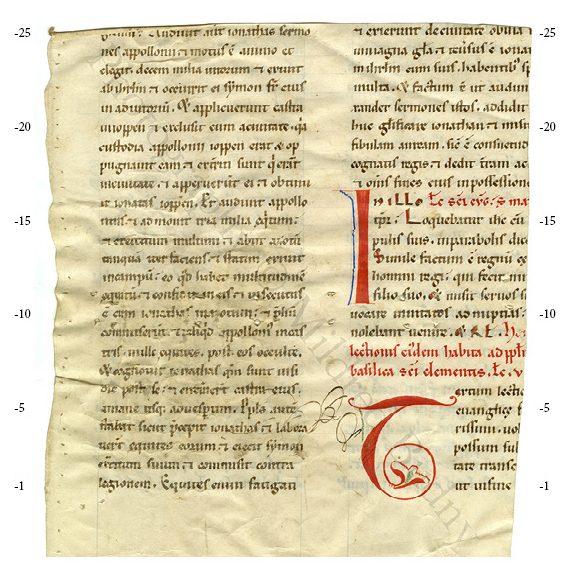 LECTIO SANCTI EVANGELII SECUNDUM MATTHAEUM
LECTIO SANCTI EVANGELII SECUNDUM MATTHAEUM
In illo
tempore, loquebatur [as Migne, not as Etaix ‘dicebat’] Iesus cum disci-
[I.e. om. turbis parabolam hanc; + cum discipulis suis in parabolis, dicens
About this variant see below]
pulis suis. in parabolis, dicens:
Simile factum est regnum caelorum
homini regi qui fecit nuptias
filio suo, et misit seruos suos
uocare inuitatos ad nuptias, et
nolebant uenire. Et Reliqua Lectionis. (‘And the Rest of the Reading’, to be supplied from memory or from a copy of its text.)
Thus is omitted the rest of the Matthew citation in the Homily, from Iterum to electi, that is, all of verses 4–14, corresponding to lines 5–21 of the Gospel Reading in Étaix’s edition, page 359.
Next comes the opening title for the Homily proper.
HOMILIA XXXVIII,
lectionis eiusdem Habita ad populum in
basilica sancti [in contrast to beati] Clementis. Lectio V. . .
[That is, ‘our’ leaf conforms with Étaix’s preferred sancti (found in his Witnesses T, B, F, L, N, and M, as opposed to beati found in Witnesses E, S, Ba, V, J, among his 11 chosen manuscripts, mostly early) as noted in the apparatus for his edition, page 359, for Tit.[ulum (“Title”), line 2. More about the witnesses and the value of this one below.]
- [Lines rb -6 to -1]
Textum lectionis
euangelicae, fratres ca-
rissimi, uolo, si
possum, sub brevi-
tate transcurrere,
ut in fine eius ualeam /
[The top of Column va would presumably have begun thus:
ad loquendum largius vacare. Sed quaerendum prius est an haec apud Matthaeum ipsa sit lectio quae apud Lucam sub appellatione coenae describitur (Luc. XIV, 16, seq.). Et quidem sunt nonnulla quae sibi dissona esse videntur, quia hic prandium, illic coena memoratur; hic qui ad nuptias non dignis vestibus intravit repulsus est, illic nullus qui intrasse dicitur repulsus esse perhibetur. Qua ex re recte colligitur quod et hic per nuptias praesens Ecclesia, et illic per coenam aeternum et ultimum convivium de-/]
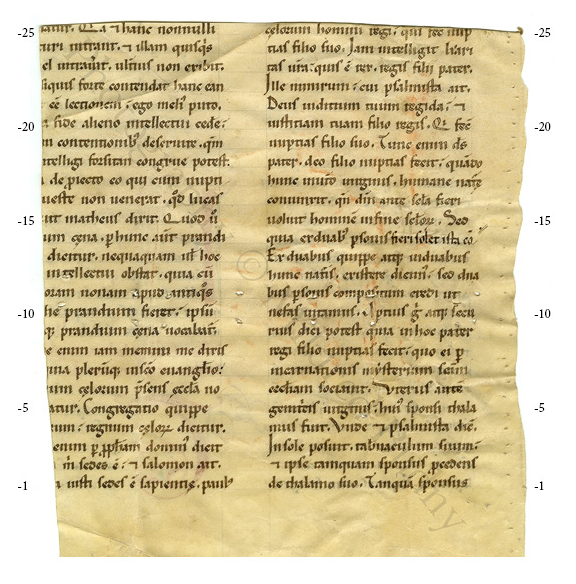 signatur, quia et hanc nonnulli
signatur, quia et hanc nonnulli
exituri intrant, et ad illud quisquis
semel intraverit ulterius non exibit.
At si quis forte contendat hanc eam-
dem esse lectionem, ego melius puto,
salua fide, alieno intellectui cedere,
quam contentionibus deseruire, quoniam
et intelligi congrue forsitan potest
quia de proiecto eo qui cum nupti-
ali veste non uenerat quod Lucas
tacuit, Matthaeus dixit. Quod vero
per illum coena, per hunc autem prandi-
um dicitur, nequaquam uel hoc
nostrae intelligentiae obsistit, quia cum
ad horam nonam apud antiquos
cotidie prandium fieret, ipsum
quoque prandium coena uocabatur.
- Saepe autem [>enim] iam me dixis-
se memini quod [>uia] plerumque in sancto Evangelio
[these variants appear to be unrecorded elsewhere]
regnum coelorum praesens Ecclesia no-|
inatur. Congregatio quippe
justorum regnum coelorum dicitur.|
uia enim per prophetam Dominus dicit:
Coelum mihi sedes est [Isai. LXVI, 1]; et Salomon ait:
Anima justi sedes est sapientiae [Sap. VII, 27]; Paulus
[Column va / vb would presumably have begun thus:
etiam dicit: Christum Dei virtutem et Dei sapientiam (I Cor. I, 24); liquido colligere debemus quia si Deus sapientia, anima autem justi sedes sapientiae, dum coelum dicitur sedes Dei, coelum ergo est anima justi. Hinc per Psalmistam de sanctis praedicatoribus dicitur: Coeli enarrant gloriam Dei (Psal. XVIII, 2). Regnum ergo coelorum est Ecclesia justorum, quia dum eorum corda in terra nil ambiunt, per hoc quod ad superna suspirant, jam in eis Dominus quasi in coelestibus regnat. Dicatur ergo: Simile est regnum
The remaining part of Column vb picks up again here:]
coelorum homini regi, qui fecit nup-
tias filio suo.
[3.] Jam intelligit hari- [for chari-}
tas vestra quis est iste rex, regis filii pater:
ille nimirum cui Psalmista ait:
Deus judicium tuum regi da, et
justitiam tuam filio regis [Psal. LXXI, 1]. Qui fecit
nuptias filio suo. Tunc enim Deus
pater Deo Filio suo nuptias fecit, quando
hunc in utero Virginis humanae naturae
conjunxit, quando Deum ante saecula fieri
voluit hominem in fine saeculorum. Sed
quia ex duabus personis fieri solet ista con-
[Omitted: junctio, absit hoc ab intellectibus nostris, ut personam Dei et hominis Redemptoris nostri Jesu Christi ex duabus personis credamus unitam.]
Ex duabus quippe atque in duabus
hunc naturis existere dicimus; sed ex dua-
bus personis compositum credi, ut
nefas, vitamus. Apertius ergo atque secu-
rius dici potest quia in hoc Pater
regi Filio nuptias fecit, quo ei per
incarnationis mysterium sanctam
Ecclesiam sociavit. Uterus autem
genitricis Virginis hujus sponsi thala-
mus fuit. Unde et Psalmista dicit:
In sole posuit tabernaculum suum,
et ipse tanquam sponsus procedens
de thalamo suo [Psal. XVIII, 6]. Tanquam sponsus
[Column vb ends here. The text on the next leaf may have continued thus, at least in part:
/ quippe de thalamo suo processit, quia ad conjungendam sibi Ecclesiam incarnatus Deus de incorrupto utero Virginis exivit. Misit ergo servos suos ut ad istas nuptias amicos invitarent. Misit semel, misit iterum quia incarnationis dominicae praedicatores, et prius prophetas, et postmodum apostolos fecit. Bis itaque servos ad invitandum misit, quia incarnationem Unigeniti et per prophetas dixit futuram, et per apostolos nuntiavit factam. Sed quia hi qui prius invitati sunt ad nuptiarum convivium venire noluerunt, in secunda invitatione jam dicitur: Ecce prandium meum paravi, tauri mei et altilia occisa sunt, et omnia parata. . . . ]
The Worth of the Witness
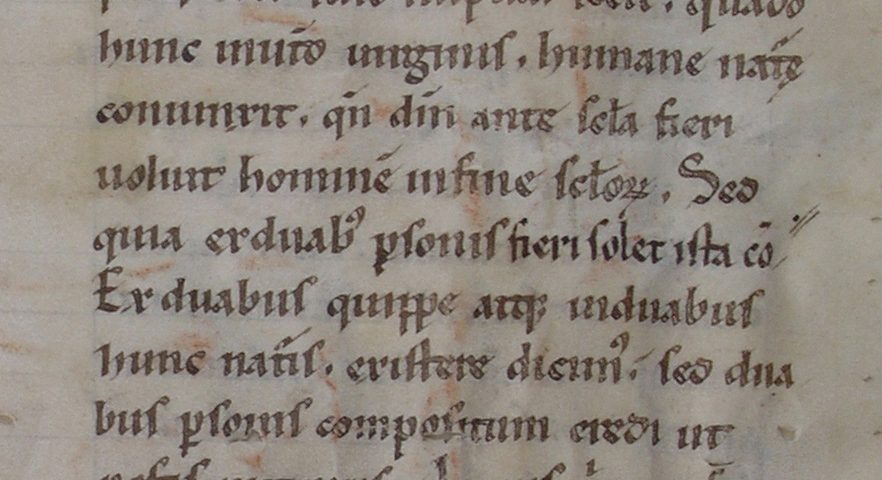 The transcription error by omission between lines -13 and -14 in column vb does not seem to be recorded for other witnesses, to judge by the editions. It introduces a gap mid-word (coniunctio), by moving straight to another statement altogether, bypassing text which might have occupied some 4 or 5 lines of similar layout — although the span in the unknown exemplar may be difficult to calculate. The mistake may be explainable through eyeskip passing from one phrase ex duabus (within line -14, abbreviated as ex duab’) to the next Ex duabus within the exemplar.
The transcription error by omission between lines -13 and -14 in column vb does not seem to be recorded for other witnesses, to judge by the editions. It introduces a gap mid-word (coniunctio), by moving straight to another statement altogether, bypassing text which might have occupied some 4 or 5 lines of similar layout — although the span in the unknown exemplar may be difficult to calculate. The mistake may be explainable through eyeskip passing from one phrase ex duabus (within line -14, abbreviated as ex duab’) to the next Ex duabus within the exemplar.
The mistake is marked discreetly by a set of reader’s marks, also in dark brown ink, at the end of the line. Raised above the letter-height and leading into the margin, there appears a diagonal pair of parallel lines following a rounded dot ( •// ). At the baseline beside the final letter there rises another, shorter diagonal line at a similar angle. One might think that the omission mark might have been intended for a matching mark and supplied reading somewhere on the page, in accord with time-honored practices of noting, and remedying, textual errors in medieval manuscripts, with pairs of omission-and-insertion-signs, sometimes identical and sometimes mirrored. Many of those inventive practices are described and surveyed Assembly Marks in the Vivian Bible and Scribal, Editorial and Organizational Marks in Medieval Books.
Some of the variant readings of the leaf appear to have no recorded matches, at least among the 11 witnesses (with the sigla T E B S Ba F V J L N M) selected for this Homily in Étaix’s edition. They are listed in his textual apparatus at the foot of each page, and identified on his pages xiv–xxiii.
This version shares (in column va line -7) the reading of basilica sancti clementis in the Title with Witnesses T, B, F, L, N, and M, as opposed to beati in Witnesses E, S, Ba, V, J. For what it’s worth, in a small sample of text, we might take note of the identity of these manuscripts, which exhibit a geographical spread. Could do. Already (see above), we have noted some variants, as with the spelling haritas for ch- (Column vb line -24 within Section 3 line 1) and the variants at the beginning of Section 2 (Column va lines -8 and -9).
However, more useful for considering the paths of transmission may be the paraphrase within the opening verses of the Gospel reading itself. The ‘authorized’ text for Gregory’s Homily 38 has turbis parabolam hanc (as in the editions), whereas ‘our’ text (Column rb lines -15 and -14) has cum discipulis suis in parabolis, dicens . . .
This version appears rather frequently in lectionaries or other formulaic presentations — Missals and Homiliaries, for example — in medieval manuscripts after the ‘establishment’ of the text of Gregory’s Homily.
Some examples:
- Aelfric’s Catholic Homilies, for Sunday XXI after Pentecost.
- Sarum Missal
They demonstrate a transmission within other forms than either the ‘authorized’ Gregorian text or the standard Vulgate. Without having the full expertise for this sphere of liturgical practices across many centuries, I venture to suggest that this version may conform with liturgical practices more than with some “literary” transmission of the text.
The Layout of the Land
By revealing the possible extent of the textual gaps, provided that the original manuscript corresponded more-or-less precisely with the established editions, the transcriptions may allow for conjectured reconstructions of the full extent of the leaf. Such conjectures would have to allow for whichever abbreviations the scribe would or could have used, as well as for possible variants which the exemplar may have exhibited. Even so, we might make educated guesses about the number of lines which the text would have required from the lost tops of the columns on both sides of the leaf. Would you like to guess?
Given the same rate of script-to-text, it seems likely that the surviving portion represents somewhat more than half the original whole, and perhaps as much as about 2/3. Normally I prepare closer conjectures, but this case seems to exibit some variables which should allow for, or require, a wider range in view of the losses of the evidence and the possible variants in presentation of the text.
AddOns
A set of scribbles producing series of overlapping oval strokes in dark brown ink stretches across the end of lines -1 to -6 in column ra, spans the intercolumn, and loops into the left-hand cusp of the initial T. Perhaps practising part or parts of a signature, the set appears to comprise a pen-trial inducing the flow of the ink more readily as the strokes progress. The scribble seems early modern or modern. It may correspond to the period of removing the leaf from its former manuscript and turning it to reuse for a new purpose in wrapping some contents or other.
The paired holes or punctures which extend irregularly roughly halfway across the extant leaf and the unsteady line of pricks undulating down its irregularly trimmed inner edge likewise belong to a subsequent stage or stages in the history of the leaf. Presumably they relate to processes of stitching or impaling the structure. Is it possible that these unsteady and uneven rows of holes did not receive an intended stitching, and the fragment prepared for reuse did not receive it? Such a reject could resemble the printers’ waste known from many contexts.

The pronounced folds in asymmetrical formation across the leaf and the reddish brown stains acquired by rubbing from an adjacent entity, perhaps the binding of a volume, attest to reuse across some time, before the retrieval of the leaf as an entity on its own for sale in Florence.
Wrapping Up
About the Wrapper. The fold-lines on the fragment do not indicate a standard form, at least in our collective experience. Not a customary binding cover or folder, as exhibited in some of our earlier blogposts in this series and in many other collections.
Accordingly, I decided to take detailed photographs on a Road Show & Tell, as my journeys for conferences or other tasks allowed. It is great what can happen when you, and we, look. In a word, Bingo! (It doesn’t always work, but, when it does, hey!)
Here are stages in the process of consideration, reflection, and demonstration, with the time-tested method of Try, and Try Again.
The time and place? We were relaxing and conferring at an appointed interval at the 2015 Annual Meeting of the Medieval Academy of America, with its Executive Director, Lisa Fagin Davis (our Associate and a former Trustee) presiding. I brought the photographs from the Handbook, questions included. ‘Our’ leaf with the Maccabees/Homily fragment raised special interest.
To Whit. These are unusual folds. Yes, agreed. What form of wrapper might they show? Hmm. Challenge accepted.
Dot Porter and Lisa Fagin Davis rose to the challenge, and I listened, happily.
And so, step by step:
An unusual folder is revealed in its full glory. Hands-on reconstruction solves the case. Go team!
*****
We thank the owner of the leaf for permission to photograph, study, and publish it. We thank Dot Porter and Lisa Fagin Davis for permission to include the photographs of the Folding Quest, with such happy results.
Do you know of any other leaves from the same manuscript? Would you like to make a closer guess about the number of lines of text which the original leaf had? Do you recognize the scribe’s work? Have you encountered a similar folder or folding pattern for a reused medieval leaf? Please let us know.
Feel free to Contact Us or add your Comments here or on the Research Group’s Facebook Page.
*****
Next Stop: More Manuscripts! Or Manuscript Fragments. More Evidence to consider.
*****

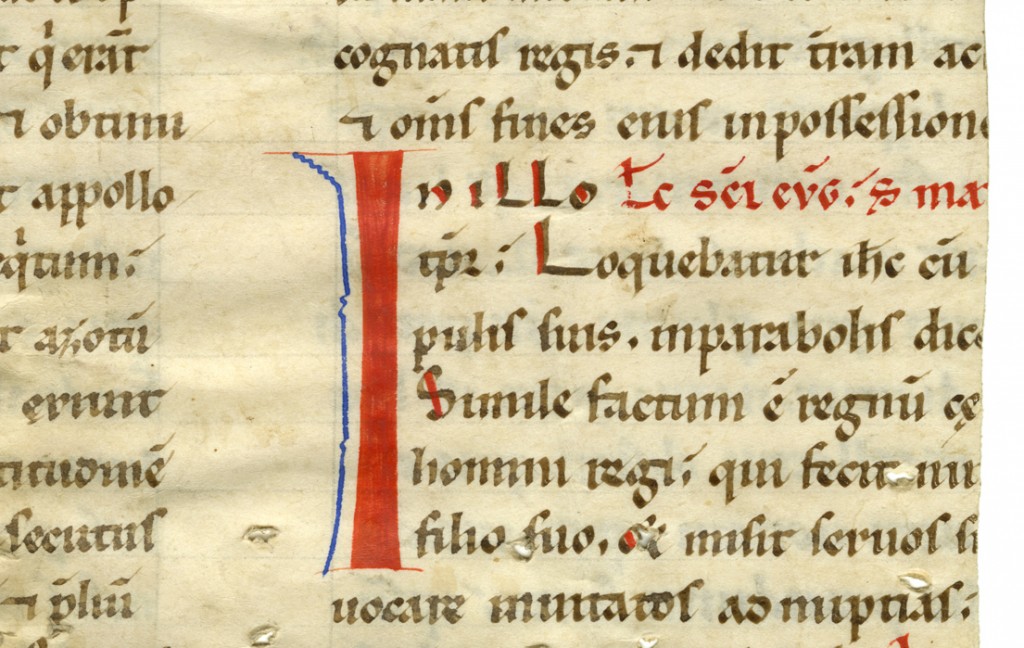
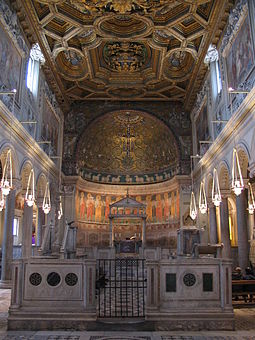

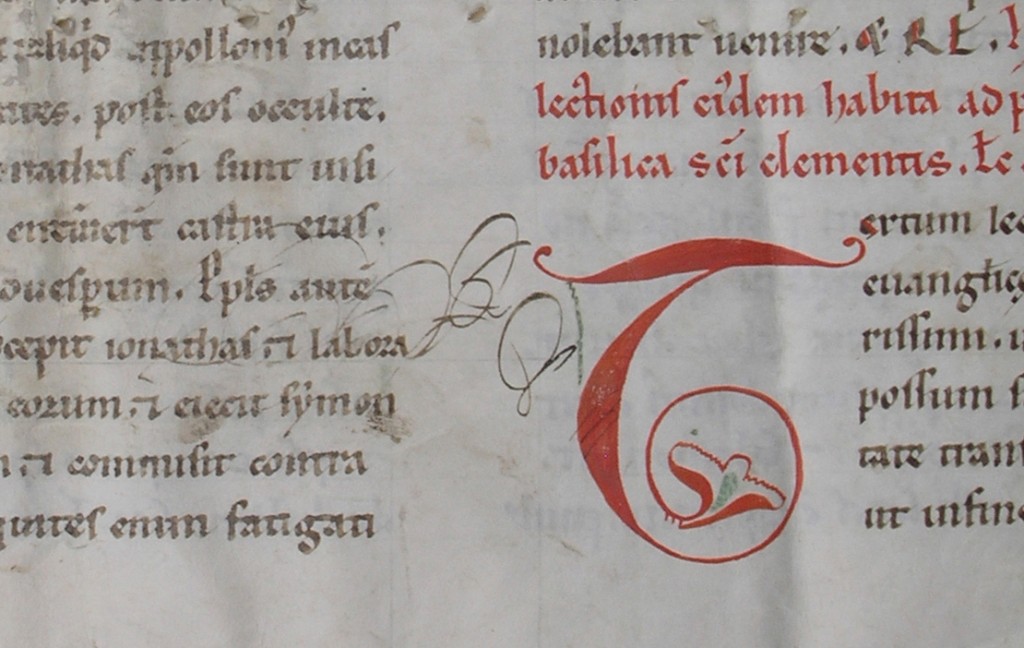
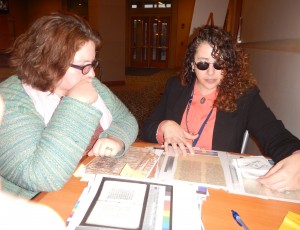
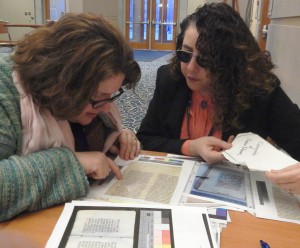
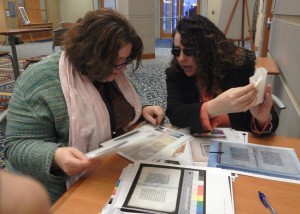
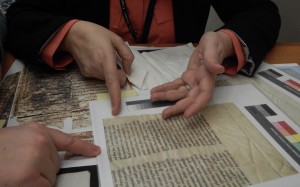
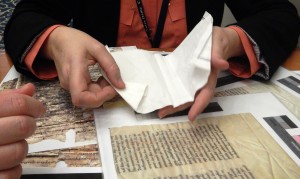
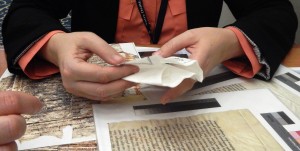
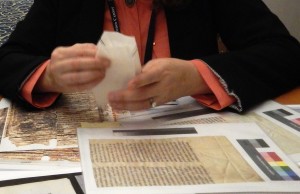
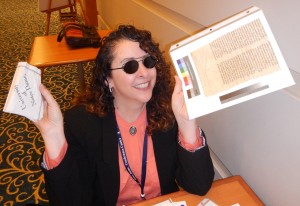
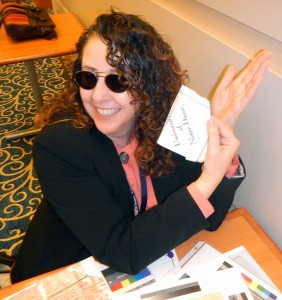
The script looks decidedly Spanish to me.